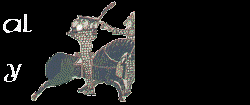| Back |  |
Main page |
A tant vit une aumaire ouvrir Et une wivre fors issir, Qui jetoit une tel clarté Con un cierge bien enbrasé... la bouce ot tote vermelle. Par mi jetoit le feu ardant... Les iols avoit gros et luissans... De la keue trois neus avoit, C'onques nus hom ne vit grinnor. Li Biaus Descousneüs, Renaud de Beaujeu. Original Text of the 13th century. Then he saw a cupboard opening And a dragon getting out of it, That shined like a blazing candle... it had a ruby mouth and belched out an ardent fire. Its eyes were large and brightening... It had three knots on its tail, and nobody had ever seen a bigger one. |
 |
| The dragon is a typical topic in the
chivalry novel. It corresponds, most of the time, to an
episode where the knight must show his braveness. It
refers to the image of the snake and then can be
deceiving, like the one of the Bible. In front of that
anomalous being, the knight must be fairer than ever. In
the extract that's displayed above, the knight stops
himself from striking the beast because it seems to
humiliate itself in front of him. This braveness allows
him to learn his name from a magical voice appearing from
nowhere (yeah... that poor boy didn't know his own name,
is that sad...) The dragon, mythical creature made of
different real animals, refers also to the opposite
feelings that coexist in the human's heart. Beating the
dragon is finding the peace in oneself. Illustration: Moralia in Job. 12th century. |
|